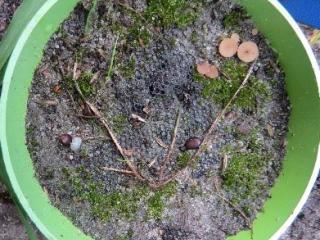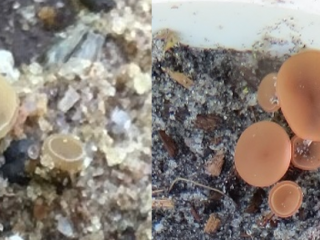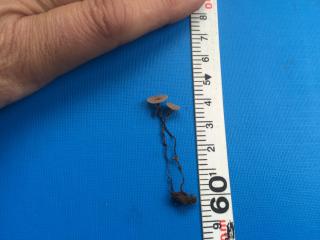Sclerotinia apothecia are being found
-
Gibson (DPIRD’s Esperance Downs Research Station)

As part of a GRDC funded project into epidemiology and decision support tools, depots containing Sclerotinia sclerotia have been established at 7 locations in WA in 2021. Sclerotia in a depot at the Esperance Downs Research Station (near Gibson) have just started to germinate in late May and produce apothecia. The sclerote depot is in a barley crop under a very thick canopy.
This finding is a warning that the Sclerotinia disease cycle is commencing in the Esperance area. No apothecia have been observed at any other locations.

Apothecia are small cream-apricot coloured mushroom cups measuring 5-15mm in diameter that appear from the germination of sclerotia (hard black fruiting bodies/resting structures of sclerotinia) under favourable conditions. While they can vary somewhat in colour, they all tend to darken over time and can survive for around three weeks before withering away.
Carefully digging out the apothecia will usually show you its connection back to the sclerote it germinated from.
Apothecia release massive numbers of ascospores that cause sclerotinia stem rot via infecting petals in all broadleaf crops including canola, lupins, chickpeas, lentils, field peas, faba beans, lucerne and weeds (wild radish and cape weed). These infected petals fall into the crop canopy and under humid, damp conditions can cause stem infection, this is the most common infection pathway. In some years, particularly under very wet conditions in paddocks that have high inoculum levels, basal infections pre-flowering have been observed. Basal stem infections can develop from infected leaves that touch the ground or direct growth over/under the soil from sclerotia to the stem. White masses that are fungal hyphae (on leaves, soil or stem bases) are the key symptom to look for.
Growers are urged to start planning for Sclerotinia management in their canola crops if they are close to or at flowering. We currently have canola crops in WA ranging from the four leaf stage, cabbage stage, bolting and crops that are already flowering. Although canola crops are at variable growth stages in the state, the most vulnerable canola crops are the ones that have just started to flower or are flowering. These may require fungicide protection.
DPIRD research over the past few years has shown that as a rule of thumb regular rainfall and high humidity (>75%) in the three weeks before and after commencement of flowering are most conducive for the damaging levels of disease to occur in crops.
Growers need to consider the following factors to determine their risk of sclerotinia:
- rotation history of the paddock
- history of sclerotinia in the current paddock and those surrounding it
- rainfall events before and after flowering
- growth stage of canola.
The SclerotiniaCM decision support tool is available for use during crop flowering to help growers/consultants determine the likely economic returns from applying fungicide at a specific time during flowering. The tool uses a forecasting model and the user can specify individual paddock data/history as well as recent and expected weather conditions so that the output relates to their own cropping circumstances. The SclerotiniaCM tool can be downloaded from the App Store or Google Play Store onto your iPad or Android tablet. For more information refer to DPIRD’s SclerotiniaCM decision support tool page.
Several fungicide products are registered for the control of Sclerotinia in canola. Fungicides need to be applied as recommended per product label and no later than 50% bloom. For more information refer to DPIRD’s Registered foliar fungicides for canola in WA page.
Based on the extensive research conducted by DPIRD over the last few years the following in-season sclerotinia management options are recommended;
- Apply a single foliar application at 30-50% bloom, provided conditions are favourable for infection before and during flowering. See Table 1 below for recognising bloom stages in canola. Use the SclerotiniaCM tool for guidance.
- A second fungicide application at 50% (full) bloom is only beneficial in seasons with an extended wet period. Use the SclerotiniaCM tool for guidance.
- If growers notice ground infections they can apply a foliar fungicide immediately or wait until 20% bloom to prevent further new infections.
- Fungicide application is still warranted in crops with wide row spacing (up to 44cm) if the seasonal conditions (high rainfall and humidity) become favourable during flowering.
| Percent bloom | Number of flowers open on the main stem |
|---|---|
| 5% | <5 |
| 10% | 10 |
| 20% (petal drop commences) | 11-14 |
| 30% | 15-20 |
| 50% | >20 |
Growers and consultants are encouraged to report to the PestFax service any apothecia finds or disease observations as the season progresses.
Further information can be found at the department’s Managing sclerotinia stem rot in canola page and GRDC’s Sclerotinia stem rot in canola factsheet.
For more information on Sclerotinia contact plant pathologists Andrea Hills, Esperance on +61 (0)8 9083 1144, Ciara Beard, Geraldton on +61 (0)8 9956 8504 or Kylie Chambers, Northam on +61 (0)8 9690 2151.
Article authors: Ciara Beard (DPIRD Geraldton), Jean Galloway (DPIRD Northam) and Andrea Hill (DPIRD Esperance).

